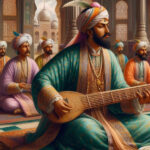Lalon Shah, also known as Lalon Fakir (1774-1890), was a well-known philosopher, poet, composer, social reformer, and secular thinker. In Bengali culture, he is renowned as a symbol of religious tolerance and secularism, and his songs have inspired many poets as well as social and religious intellectuals. There is little information accessible regarding Lalon’s early life because he was quite private about his history. Despite this, much speculation has surrounded his physical appearance, religious upbringing, and other parts of his life. According to one account, Lalon was born to Hindu Kayastha parents and abandoned by his companions on the Ganges after getting smallpox during a journey to Murshidabad. He was subsequently taken in by Malam Shah and Matijan, members of the weaver community in the Muslim-dominated village of Cheouria, who gave him a place to reside. Lalon formed a musical group and dedicated himself to composing and singing songs, receiving inspiration from Shiraj Shai, another singer from the same area. While others claim Lalon adopted Islam and married a Muslim woman, the circumstances are unknown.
Lalon left no sign of his birth or ‘origin’ and kept his background hidden for fear of being cast into class, caste, or communal identities by a fragmented and hierarchical society. Despite his silence on his roots, communal appropriation of this great politico-philosophical figure has sparked debate over whether he is a ‘Muslim’ or a ‘Hindu’ — a’sufi’ or a disciple of the ‘bhakti’ tradition—a ‘baul’ or a ‘fakir’, etc. He is none, as he has always strived to transcend identity politics.
Some of the famous song composed my Lalon Fakir are popular songs are “Sob loke koy lalon ki jat songsare”, “khachar bhitor auchin pakhi’, “jat gelo jat gelo bole”, “dekhna mon jhokmariay duniyadari”, “paare loye jao amay”, “milon hobe koto dine”, “aar amare marishne maa”, “tin pagoler holo mela”, etc.
Lalon’s melodies provide subconscious exposure to the reality and truth of life that exists beyond our material world and realism. They convey an inexplicable feeling. To an immersed listener, his melodies open and close a narrow passageway to the other world beyond the opaque glass ceiling of this one. Lalon sublimates the conclusions of the principal schools of his time: the Nadia school founded by Adaitacharya, Nityanando, and Chaitanya. This school differs from Lord Chaitanya’s Achinta-vedavedbad (the anitonomous realism of individual soul and Supersoul, both of which remain eternally), which emerged during Sri Chaitanya’s post-Nadiya period. This latter phase gave rise to Vaishavism. Nadiya’s movement has historical ties to Vrindabon, however they are two separate schools. Fakir lalon Shah opposed the upper caste elite’s reappropriation of Chaitanya’s popular political campaign against caste, class, and patriarchy during his time, resulting in the degeneration of Bengal’s great bhakti movement.
Lalon was aware of the socioeconomic situations around him at his time and this is reflected in his songs, which address everyday issues in simple language. It is estimated that he composed over 10,000 songs, of which 2000-3000 can still be found today, while the rest have been lost to time and the hearts of his many followers. Most of his followers were unable to read or write, and so very few of his songs exist in written form. Lalon has no formal education, but his melodies can instruct even the most educated minds around the world.
Birth and death are the realities of this world and the mind is the bascis of the human soul which is core basis of the Baul community. The existence of the Supreme Being is known by knowing You. Lalon has realized the Supreme Being in his existence and believes that the mystery of existence can be connected with the unconscious by looking deeply and sincerely, reading and introspecting. Therefore, in the midst of knowing and receiving the truth, he has resorted to the body only for the purpose of attaining the ‘Absolute’. In the music of Lalon Fakir, special emphasis is given on breath or breathlessness in the basic meditation of religious practice.
Fakir Lalon Shah is considered to be one of the most influential spiritual leaders in the Indian subcontinent. He is a Baul saint, a strong voice of equality and humanity, a lyricist, composer and singer of Baul songs. He is also known as the Baul Emperor. Fakir Lalon did not get higher education in school, college, university or any other educational institution, but through his own efforts, he learned a lot about different religions, people, society and culture, history and tradition, different rituals and secrets of creation and the Creator. And that is reflected in every song he has written. The influence of spirituality, humanity and mysticism has become evident in his songs. Lalon Sai was a saint who gave the highest place to humanity by moving away from religion, caste, tribe and caste. Lalon Fakir has given importance to humanity by discarding caste, religion and social superstitions in his songs.
Lalon’s philosophy exemplifies the fundamentals of liberal humanism and individualism, as well as the value of the soul above the body. Prominent works of Bengali literature are rife with enlightened borrowings from Lalon, despite his significance and widespread influence going unnoticed. Lalon’s ideology is based on ancient writings such as “Deho-Totto” and “Sahajiyana”. This article will trace Lalon’s history through ancient literary writings, demonstrating the links between his philosophy and American Transcendentalism, European modernism, the Romantic and Symbolic Movements. Lalon Sai remains in our heart through his songs and lyrics which are immortal till date and becoming more popular in passing of time. Lalon fought against caste and religious discrimination. He wanted to create a caste-less society. He placed humanism above all else.According to various sources, Lalon did not observe any religious rituals during his lifetime. Through his own practice, he acquired knowledge of both Hinduism and Islam. There are many examples in his poetry.
Lalon’s only sketch during his lifetime was made by Jyotirindranath Tagore, the brother of Rabindranath Tagore. A year before Lalon’s death, on May 5, 1889, he made this pencil sketch while sitting in his boat on the river Padma – which is preserved in the Indian Museum.
References :
https://www.bbc.com/bengali/news-50202856
Choudhury, A. A. (1992). Lalon Shah ISBN 984-07-2597-1
Tagore, R.; Stewart, T. K. (translator); Twichell, C. (translator) (2003), Rabindranath Tagore: Lover of God, Lannan Literary Selections, Copper Canyon Press (published 1 November 2003), ISBN 978-1-55659-196-9
Enamul Haq, Muhammad(1975), A history of Sufism in Bangla, Asiatic Society, Dhaka.
Qureshi, Mahmud Shah(1977), Poems Mystiques Bengalis. Chants Bauls Unesco. Paris.
Siddiqi, Ashraf(1977), Our Folklore Our Heritage, Dhaka.
Karim, Anwarul(1980), The Bauls of Bangladesh. Lalon Academy, Kushtia.
Capwell, Charles(1986), The Music of the Bauls of Bengla. Kent State University Press, USA 1986.
Bandyopadhyay, Pranab(1989), Bauls of Bengal. Firma KLM Pvt, Ltd., calcutta.
Mcdaniel, June(1989), The Madness of the Saints. Chicago.
Sarkar, R. M.(1990), Bauls of Bengal. New Delhi.
Brahma, Tripti(1990), Lalon : His Melodies. Calcutta.
Gupta, Samir Das(2000), Songs of Lalon. Sahitya Prakash, Dhaka.
Karim, Anwarul(2001), Rabindranath O Banglar Baul (in Bengali), Dhaka.
Choudhury, Abul Ahsan(editor)(2008), Lalon Samagra, Pathak Samabesh.
External links
Lalon Fakir: Saint Lalon by Machizo Documentary on Lalon’s Life and Philosophy. (UnnayanTV)
Lyric of pabe samanye ki tar dekha in Manipuri translated by Konthoujam Suranjit



